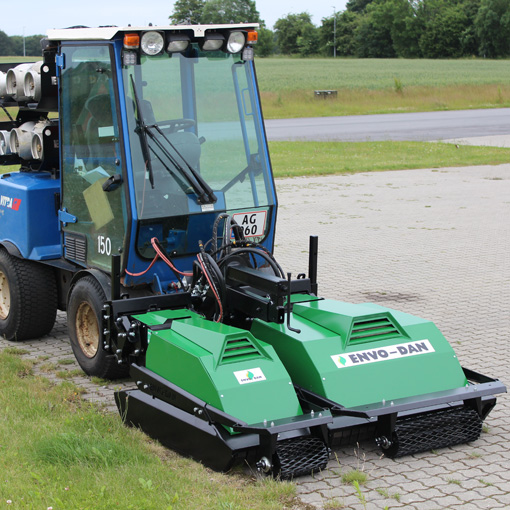What is thermal weed control?
Thermal weed control is the technique of using heat to control and eliminate weeds, fungus diseases, and insect pests.
Historical facts about weed control
This type of weed control is the oldest type of weed control since the first farmers in ancient Egypt already used this type of control for their crops. Remains have even been found from the Neolithic era when fire was already used. Returning to the modern era, we found it in the USA around 1850. John A. Craig first patented a flame-weeding machine for sugarcane fields.




Flame weeding and the way it works
Thermal weeding plays a major role as a biological control in agriculture. The main advantage of flame weeding is the absolute absence of harmful residues in the soil, in fact, LPG, when burned, forms only water vapour and CO₂. The principle on which the flame weeding technique is based is that of boiling the weed tissue. The time of action of the heat during the treatment is so short that it does not allow carbonization of the plant material.
The immediate effect of the heat is to cause the cell plasma to expand sharply, thus causing the outer membrane to rupture; the intracellular flow of nutrition is thus interrupted; the cell can no longer nourish itself, and, because of the continuous evaporation caused by the tearing of the cuticle, within two or three days, the plant dries up and dies. Therefore, flame weeding does not burn the weeds, but immediately after the heat treatment, the treated plants show a change in pigmentation; the green colour of the leaves is strongly accentuated. This manifestation is visible within a couple of minutes and is due to the release of sap from the cell.
Exposure to high heat leads to overheating and eventual rupture of the plant tissue. It’s important to note that the weeds don’t need to be burned to a crisp to be killed; this will only ensure that you waste time and fuel in the process. If you squeeze the plant and notice your thumbprint indent on the plant, you know your flame weeding has been successful.
Flame weeding benefits the environment
From an ecological point of view, flame weeding has a minimal environmental impact. Since the combustion of LPG only forms water vapour and CO₂. The heating of the surface layers of the ground, brought about by the rapid passage of the burners, brings the surface itself to a temperature that often does not exceed 60-80 °C, a temperature that we can easily experience even in the hottest hour of the summer season. Damage to soil microflora and microorganisms is therefore minor; there is no risk to operators, and no toxic residues are released into the environment.
Another result that can be achieved, from an environmental hygiene point of view, is reducing the speed, which allows the surfaces, pavement, or concrete floors to reach slightly higher temperatures (80-100 °C), which removes pathogenic germs and allows an effective sterilisation operation. At the same time, it dries roads quickly, so they can be paved faster.
Cost and consumption of weed burning solution
With the application of this technology, the costs involved can be determined immediately since this weed control technique does not give rise to any environmental pollution other than CO₂, and any additional costs incurred after the treatment is carried out and due to the disposal of any toxic residues are therefore equal to zero.
Gas consumption is closely linked to the type of farming equipment used and the amount and height of the weeds to be treated. The most suitable conditions for the use of the weed burner technique are obtained when the weeds to be treated are at the seedling stage.


What to know before buying a weed burner?
There are many organic and environmentally friendly weed control solutions on the market, and they are not all the same, so choosing between them can be overwhelming. In this article, we’ve compiled the four most important questions you should ask yourself to narrow down the market before you invest in an agricultural weed burner.
By asking yourself a few easier questions, you can get closer to finding the solution that suits your cultivation system and needs.
1. What do you need the weed burner for?
It is essential that we understand clearly what you are going to burn. Depending on the type of crop or service, you have to choose between a flat burner or an in-row burner for crops already grown. Each crop needs a specific burner. The weed burner will be adapted to the farmer’s cultivation system.
2. How expensive is it to use a weed burner?
You need to find ways to reduce the costs of consumption. A weed burner uses propane gas, and its only polluting residue is CO₂. Finding a weed burner where the reduction of gas helps to reduce CO₂ is of high importance, both for the farmer’s economy (ROI) and for the environment.
3. Working at any time of the day and in any situation
Not all weed control systems are able to work when the wind is blowing, meaning you lose days of work before germination. Find a burner that protects the flame from the wind and increases its power inside the burner.
4. Reduce gas consumption and give safety a high priority
A weed burner must be safe for everyone who has to work with it, the crops, and the environment. Therefore, it is important to buy a weed burner where a lot of knowledge and experience can be obtained from the manufacturer. A weed burner, where at the same time we reduce consumption and pollution. Tested and verified.
Optimisation of organic production
1. Perform burning to prepare the seedbed (a week before)
2. Accelerate weed growth, irrigate, and wait for all weeds to sprout
3. Plant a crop you know has an earlier germination day
4. Create a greenhouse effect with a small pane of glass over a small section of the seeded crop, germination will appear earlier, indicating that it is time to flame.


Need a professional weed burner?
Write to us or call for a free quote! We will advise you about the right weed burner for your needs.
Ole Bo Jensen, Owner ENVO-DAN

